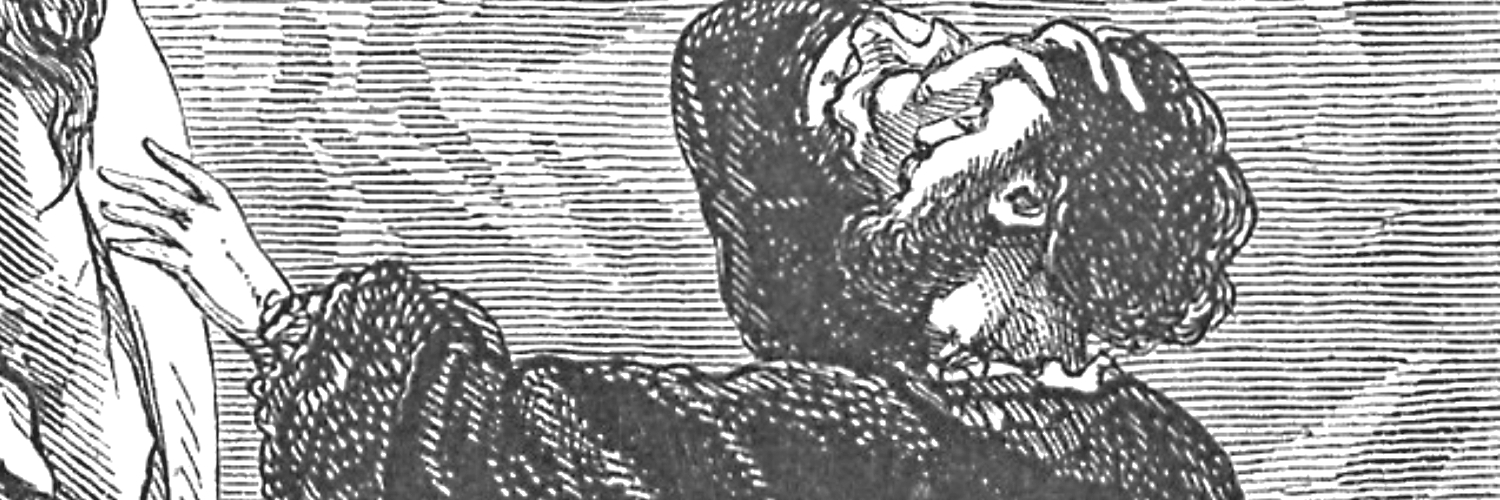In the opening scene of the play, Manfred tells the spirits to appear “in your accustom’d forms” (I.i.180).
In response, they ask him to “choose a form –” and Manfred replies: “I have no choice” (I.i.183-4). This is not only an expression of doomed fatefulness (because the shape can only be Astarte), but also a world-weary “I don’t care” or, as my teenage son would say, just before he gets grounded, “I don’t give ––.”
Manfred’s “I have no choice” is a kind of textual shrug – one which Byron redeploys in the fair copy of Don Juan Canto II, stanza 151, when he offers alternative metaphors to his publisher. As shown below, he writes in the margin of the manuscript, “Take of the variations what is thought best –– I have no choice.”
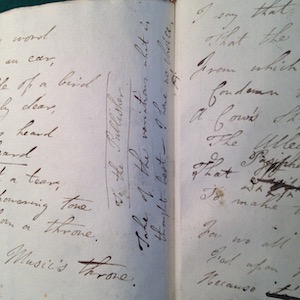
This paper examines the expressive mark of punctuation that leads to “I have no choice”—the long dash (reproduced by Byron’s printers and in this paper as a double “em” dash “–”), which has a distinctive place in Manfred and Byron’s writing as a whole. Like the “em” dash, the long or double “em” dash is both a mark of punctuation and (in Byron’s case) a refusal to punctuate. Its ambivalence heightens our awareness of the reader as a co-producer of meaning and as one of the many who are coerced by Manfred’s (and Byron’s) assertions of authority. The long dash, therefore, encapsulates many of puzzles about the interpretive freedom of Byron’s readers, his editors and, indeed, his actors.
In reading Manfred we assume all three of these roles and none of them.
Byron is not alone in the Romantic period in his promiscuous use of dashes: the manuscripts of P.B. Shelley and Jane Austen also flicker and pulse with dashing energy, but Byron’s editors seem to have allowed a higher proportion of his manuscript dashes to appear in printed form (William Gifford, we remember, edited works by both Byron and Austen). In published form, Byron’s dashes were still controversial. The British Critic’s review of The Bride of Abydos remonstrated about the prolixity of dashes in January 1814: ‘We must protest against the effect of dashes, which occur, without any reason whatsoever, sometimes twice or thrice in one line, and never less than a dozen times in a page. (50)’ The same reviewer suspected that dashes were introduced “to give spirit to what was previously flat and a mysterious meaning to what was before unintelligible.” Encountering the same device in The Corsair, the British Critic sounded increasingly impatient: “[w]e wish the Noble Lord would omit these linear conjunctions” (March 1814, 288).
The art of Byron’s dashes was shaped by print technology as well as the diverse hands that worked over the manuscripts. When published by John Murray, Byron’s poetry normally appeared on the page in Thomas Davison’s elegant typeface in which the “em” dash almost joins the last letter of the preceding word to the first letter of the next, forming a sort of “linear conjunction.” Davison’s “em” dashes are usually seamless, but in the third stanza of the first edition of “When we two parted,” for example, which was printed by Bulmer & Co, one can see how the “em” dash occasionally gets broken in the middle, forming a sort of typographical shudder.
![Lord Byron, Poems (1816), p. 15]](https://romantic-circles.org/sites/default/files/imported/praxis/manfred/images/stabler-image2Thumb.png)
The visual frisson of the broken dash is uncommon, but affective dashing in Byron’s poetry is not unusual. Byron’s dashes often seem to be the metrical equivalent of the exclamations listed at the beginning of Don Juan Canto XV: “An ‘Oh!’ or ‘Ah!’ of joy or misery” (XV.1,] CPW V:589), or of non-verbal moments such as “a syncope, / Or a singultus” (XV.2), a sigh, an intake of breath, a yawn, a cough, an inebriated hiccup or the musical equivalent of a pause, a rest, or silence. In the midst of a densely literary work, dashes highlight the importance of the non-verbal as a marker of intense emotion. As Janine Barchas points out, however, in relation to the eighteenth-century novel, “[t]he overwhelming physicality of these moments may . . . draw attention to themselves not as innocent approximations but as telltale evidence of the habits of a master printer” (132). The translation of affect into luxurious print takes us to the heart of the reviewers’ dilemma about the Byronic hero, and the uncertainty about whether Byron’s readers were sharing the intimate secrets of a wounded soul or being taken for a ride by a shrewd marketing operation.
When the British Critic praised Byron for omitting the dashy “eye-traps” in Lara, the phrase “eye-trap” (from the 1750s, according to the OED) was used presumably as a variant of “clap-trap,” the extended pause that set apart moments of high emotion in theatrical performances, designed to attract the attention and applause of the audience.
On the page, Byron’s promiscuous “em” dashing resembles the visual appearance of the Shakespeare plays David Garrick prepared for the Drury Lane Threatre. Garrick used a dash to signal where an actor should pause for effect so that in his published adaptations, as Warren Oakley has shown, “[t]ypography indicates the location of each dramatic caesura, but is silent about the nature of the action filling the expressive pause … prompting the imagination of the reader” (34). The similarly hyperventilated appearance of the page in Byron’s Turkish Tales represents a test for the reader which is taken a stage further by the appearance of a still more elongated dash in the first edition of The Corsair (as shown in figure 3).
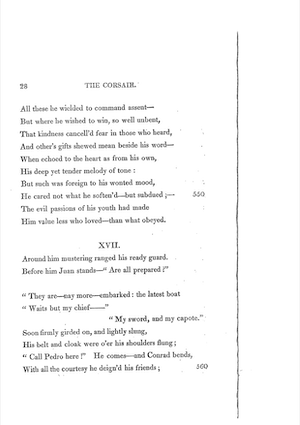
The mark after “Waits but my chief” is Davison’s double “em” dash. It is placed here to mark dramatic interruption, and is used for similar arresting effect in the prose fragment attached to Mazeppa, and for coy innuendo in Beppo: “For my part, now, I ne’er could understand / Why naughty women –– but I won’t discuss / A thing which is a scandal to the land” (stanza 68; [“em” dash in CPW IV:150, but restored to double “em” in The Major Works 333]). In the Garland facsimile of the fair copy of Beppo, one can see how Byron’s manuscript dash after “naughty Women” is at least twice the length of the dash after “For my part now,” suggesting that Byron intended a salacious pause in which to conjure and then flamboyantly repress the thought of “naughty Women” and what they do. The relative length of dashes within and between manuscripts is not always as easy to decipher, however, and, as with all his punctuation, Byron relied on his editors to translate manuscript into print.
In the fair copy of Don Juan Canto V (held until recently in the John Murray Archive at 50 Albemarle Street, London), readers can still make out the editorial hand that determined the length of the dashes (see figures 4 and 5).

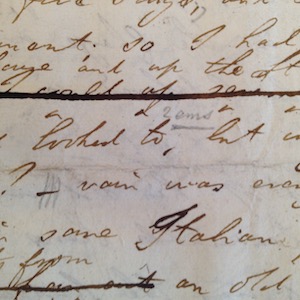
The pencil of Gifford had the authority to cancel Byron’s own ink dashes and to adjust the pauses and, therefore, the pace of the poem.
Gifford’s dashing almost always has a graphic basis in Byron’s manuscripts (in that there is nearly always a dash in the immediate vicinity), but Gifford’s usual role is to reduce the frequency of the Byronic dash and to turn it into other marks such as a comma or (especially) a colon. Like the poem’s infamous asterisks, the “2 ems” long dash in Don Juan (––) signals the unsayable; but whereas a row of asterisks shows where authorial content has been excised retrospectively by the editor or publisher to avoid obscenity or legal prosecution, the long dash suggests that a speaker nearly said something, but was then stopped or thought better of it: aposiopesis—the mark of knowing self-censorship. The long dash (––) is also a mark of complicity with the reader who is usually able to imagine what would have come next, as in Juan and Julia’s first sexual act: “And then –– God knows what next – I can’t go on; / I’m almost sorry that I e’er begun” (I. 115); or the reference to Donna Inez / Lady Byron: “His lady-mother, mathematical, / A –– never mind” (II.3); or, perhaps something less readily imaginable, “And horrid was the contrast to the view ––” (V.38), a more meditative pause as the narrator of Don Juan contemplates the body of the assassinated military commandant in Ravenna.
Murray’s printer made a distinction between the one “em” dash (–) and the “2 ems” long dash (––). In the Clarendon Complete Poetical Works (1980-93), however, some of these long dashes (including all the long dashes in Manfred in the corrected reprinting of 1992) were standardised to “em” dashes, and it was not until The Major Works that they made a reappearance. In the meantime, the new Penguin editions of Don Juan and Byron’s Selected Poems by Peter Manning and Susan Wolfson retained long dashes from the earlier Murray and Hunt editions. Viewed in the Penguin typeface, however, the difference between “em” (–) and double “em” (––) dashes seems to me slightly more subtle than in the Oxford texts (possibly because there is more space around the dash?). Since most students who want an authoritative text of Manfred will be directed to use the Clarendon Complete Poetical Works Volume IV as the current standard edition, it is helpful to ask what (if anything) is lost when we don’t see the long dashes and what are we meant to do with them when we do. I’ll begin with the dashes that we do not see in the Manfred of CPW IV because of OUP’s tidiness and I’ll move on to the ones that were not in the Manfred of 1817 because of Gifford’s tidiness.
The key editorial difficulty about retaining Byron’s dashes was summed up by Gifford [writing of The Corsair]: “Lord B. uses dashes for commas – this gives the work a very singular appearance, & in some places, mars the sense” (Nicholson, Letters 70n). Byron, like Shelley, tends to use dashes in place of other punctuation and sometimes, at least in his rough drafts, as vital contact between pen and page as he reaches for the word that will come next.
Byron trusted his editors to supply regular punctuation for him, but unlike the normal “em” dash, one feels that the long double “em” dash never really signifies a comma. Although in some respects it stands alone, the long dash shares the paradoxical and musical nature of Byron’s other dashes and extra-punctuational markings. The long dash is a horizontal (in print) or slanting (in some manuscripts) line that can signal opposing things: a fragmentary, uncertain, but logically continuous progression of thought or a termination, a change of logical direction, a pausa or pivot.
The first thing to note is that Byron often changes the position and length of his dashes between draft and fair copy. On the first draft, Manfred asks the mountains of the Jungfrau, “Why are ye beautiful? – –” with a couple of separate dashes after the question mark, but this becomes just a question mark in the fair copy and the first edition of 1817 (Levine and McGann 45).
The second thing to notice is that (as in Don Juan) some of the long dashes (––) are inserted by the editor (Gifford again), and do not exist in the MSS at all. When Manfred sees the beautiful form at the end of the first scene:
Oh God! if it be thus, and thouArt not a madness and a mockery,I yet might be most happy. – I will clasp thee,And we again will be –– (I.i.188-91, “em” dashes in CPW),
The agonised emphasis on “thou” and the long dash after “we again will be” are not present in the fair copy but were added when the fair copy was set up in type in 1817 (16).
The third thing to bear in mind is that long dashes are shared between most of the characters and are not characteristic of Manfred alone. When Peter Graham perceptively remarks that Manfred’s dashes supply the place of “dark unvoiced thoughts,” this is true in some cases, but not in all of them, and it does not extend to the other characters such as the Chamois Hunter (53). In the draft manuscript, when Manfred attempts to dismiss the Chamois Hunter with “I am not of thine order,” the man retorts: “Thanks to Heaven – / I would not be of thine – for the free fame / Of William Tell; ––” and the long dash here makes the exchange much more like the playful abruptness of dialogue in Don Juan (reminding us of the comic and conversational use of the dash in Sterne’s novels and in eighteenth-century stage comedy) (Levine and McGann 57). The cheeky long dash for the Chamois Hunter was not retained in Byron’s fair copy, nor in Murray’s first edition, but its presence on the first draft might be seen as a residual trace of the experimental serio-comic Manfred which John Wright and Jerome McGann remind us was there from the start.
Many of the long dashes that Gifford allowed into the 1817 edition are performative or gestural, telling us that in the midst of his poem, as in the narration of Don Juan, Byron (and his editor) were aware that the characters needed stage time to do something, or textual time for readers to imagine them doing something. It is significant that the agency that propels these dashes often fails to summon or dismiss or assist the body that is being invoked or cajoled repulsed, so that in the duration of the dash there is often something of a struggle with materiality (or immateriality) that might involve a certain flailing of arms. The questionable authority of speech acts is evident in Manfred’s initial commands to the spirits: “–– Rise! appear!” and “– Rise! appear! ––Appear!” (25), where the long dashes suggest something of an embarrassing pause as Manfred initially fails to make anything rise or appear.
A more solid connection between words and action is evinced when the Hunter hoists Manfred back from the cliffs with, “Away with me –– I will not quit my hold” (25). The long dashes that articulate his instructions as he leads Manfred down the mountain represent the offer of physical assistance (perhaps initially resisted, but eventually accepted) and a shared faltering progress downward. In the next act, the Witch of the Alps dismisses Manfred’s apparent attachment to a mortal, his alleged clinging on to “recreant mortality” with an “ ––Away!” (36) and, at the end of the poem, the Abbot attempts to dismiss the fiend in the third act with “Avaunt! ––”, and an equally vain “I do charge ye in the name ––” (72).
Some of the 1817 long dashes enact Manfred’s dismissal of the Wordsworthian figures, the Chamois Hunter and the Abbot: the Chamois Hunter, speaking of “heavenly patience ––” is impatiently interrupted by Manfred with, “Patience and patience! Hence – that word was made / For brutes of burthen, not for birds of prey” (28). The Abbot, remonstrating with Manfred at the start of Act III, is also cut off: “yet so young, / I still would ––” and: “Yet, hear me still ––” (61); the Spirit who comes to claim Manfred in the last act tells him, “thy many crimes / Have made thee ––” but Manfred intercepts the adjective with “What are they to such as thee?” (74). Long dashes in such instances accentuate Byron’s stichomythia, the insistent line breaks that interrupt the flow of the blank verse and enforce a poetics of un-Wordsworthian rupture.
Some of the 1817 long dashes are self-interruptions, which increase tension about what is being withheld or concealed. When Manfred speaks with the Witch of the Alps, he initiates a series of half-revelations that begin with the detail of the exceptional “one who –– but more of her anon” (33; 35). And the same secret is almost disclosed but then withheld in the most famous broken line in the whole poetic drama when Manuel speaks to Herman of “the only thing he seem’d to love, – / As he, indeed, by blood was bound to do, / The lady Astarte, his –– / Hush! Who comes here?” (66).
These are all dramatic dashes which depend on conflict between two voices (or in the last example, a change of interlocutor). In a separate category are the more lyrical long dashes which create a pause after a completed statement, allowing the last sound before the dash to reverberate. There are lots of these in the manuscript, but only one survives into the 1817 first edition. It is when the spirits ask Manfred what he wants from them and he says, “Forgetfulness ––” (see figure 6).
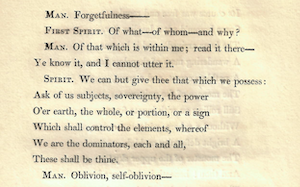
This is not an instance of interruption, or self-interruption, or aposiopesis, and the reader or speaker delivering the line has to decide for how long to pause. It is possible to imagine a performance of Manfred extended by several minutes if actors heeded all Byron’s dashes as if they were Beckett-like pauses. If we use the manuscript as a dramatical-musical score (which is how, I think, Byron wrote it), “Forgetfulness” is meant to echo round the auditorium or the reader’s mind for a bit. The long dash here (my last example of the long dashes that are present in 1817 but missing from CPW) is a way of augmenting the force of unforgettability, or the nature of consciousness with a silence that is the echo of Manfred’s own thoughts.
In order to recover some of the long dashes that Gifford filtered out of Byron’s fair copy when he copy-edited the manuscript in 1817, I have arranged the following illustrations to contrast the fair copy of Manfred (now in the Murray archive in the National Library of Scotland) and the first edition. I am using the “second issue” as described by T. J. Wise (I: 122) or the “Dramatis Personae Variant” as described by F. L. Randolph (Randolph argues that this is more likely to be the first issue) (64). First, Manfred’s soliloquy at I.i.21-4 (see figure 7).
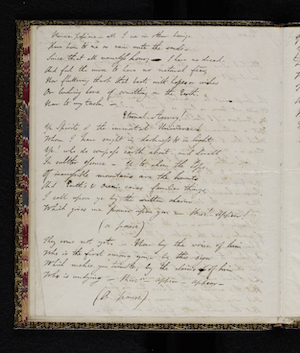
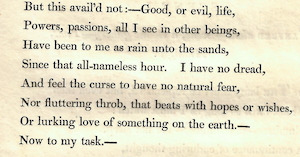
What was a succession of dashes after “sands” and “since” in the first draft (Levine and McGann 27), and a heavy long dash after “hour” in the fair copy has become just a full stop after “that all-nameless hour” in the first edition. In both manuscripts, Manfred haltingly and hesitantly approaches a fatal moment, a moment which becomes much more discreet and self-contained after it passes through the hands of Gifford. The 1817 first edition version of Manfred’s soliloquy is less uneven and more matter-of-fact, but in the fair copy manuscript above one can see a darker stroke of erasure signalling a pause to sound unfathomable agony.
At II.ii.31-2, Manfred summons the Witch of the Alps: “– to call thee thus, / And gaze on thee a moment” (see figure 8).
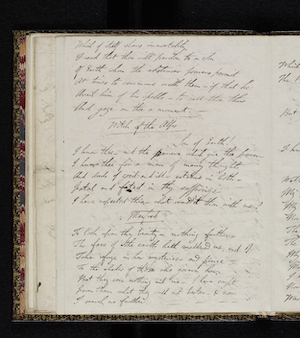
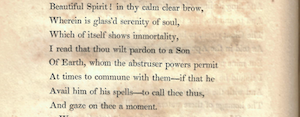
The first draft uses three separate dashes after “a moment” (Levine and McGann 63) and there is one long dash in the fair copy (above); for the 1817 edition, Gifford again turns the long dash into a single full stop. In the manuscripts, however, Byron seems to indicate that Manfred should dwell on the beauty of the Witch for some time. This impression is strengthened a little later in the fair copy when he says that he desires to “look upon thy beauty – nothing further –” and after seeking refuge in the mysteries of the earth, “I search no further. – – – –” (see figure 8). There were two separate dashes after “no further” in the first draft (Levine and McGann 64), growing to four separate dashes in the fair copy above. In the first edition of 1817, everything is gathered into a terminal full stop (see figure 9).
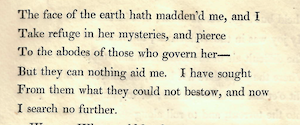
Even allowing for the fact that Byron often finishes the last line of a manuscript page with multiple dashes as a sort of “PTO” to himself, the manuscripts urge more of a pause than is audible in the grammatically rationalized punctuation of 1817. Gifford’s removal of so many dashes makes Manfred into a cooler, more composed, and more purposeful speaker in the first edition than he is in the manuscripts, where the multiple breaks and pauses in speech suggest a much more jagged melodramatic delivery.
The fair copy of Manfred’s exchange with Nemesis in Act II, scene 4 is another heavily dashed section of manuscript dialogue, indicating extreme emotional disturbance. To the question of Nemesis: “Whom wouldst thou uncharnel?” Manfred answers in the fair copy, “One without a tomb. – Call up – / Astarte. ––” (see figure 10).
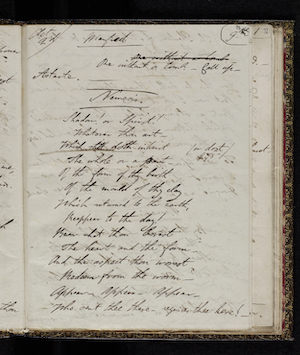
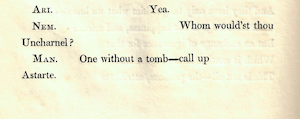
In the first edition, this exchange becomes positively brisk, closed by Gifford’s neatly self-sufficient full stop after “Astarte.” The appearance of the speech on the printed page of 1817 renders the necromancy as a routine day’s work for Arimanes and Nemesis; whilst for Manfred, the summoning of Astarte is terse rather than the more traumatic venture it appears to be in manuscript.
When Astarte appears, the stage directions for both Manfred and Astarte are implied in Manfred’s speech (see figure 11).
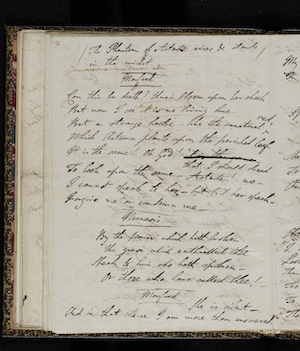
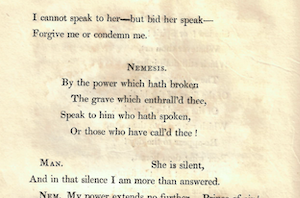
“She is silent,” we are told at II.iv.110, but when Manfred’s thick heavy dash on the fair copy becomes a comma in the 1817 first edition, what looks like unspeakable anguish in the manuscript is rendered as a calm, potentially impassive observation of her silence. Through Gifford’s paring and re-punctuating for the 1817 edition, the whole emotional temper of Manfred’s speech becomes much more even and controlled whereas Byron’s manuscripts suggest that (as usual) he was using dashes as a graphic means of drawing out and intensifying affect.
It would be misleading, however, to focus solely on dashes which carry the affective freight of the unbearable or in Hunter’s elegant phrase “something unspeakable and yet compellingly actual” (47). Dashes are used in the fair copy of Manfred for a wider range of effects, including a sort of rapture—just as in the fair copy manuscript of Don Juan X.3, dashes will carry the “glow” and “caper” cut by the poet’s “internal Spirit.” In Manfred Act III, scene i, Byronic dashes signal the boundlessness of mental travel. To the Abbot, Manfred recalls his youthful aspirations “to rise / I knew not whither – it might be to fall;” and then Manfred/Byron digresses to give us the lovely image of a Manfredian fall, which is actually an aesthetic rise (a version of the rebound or recovery described by Clara Tuite in the symposium):
even as the mountain-cataract,Which having leapt from its more dazzling height,Even in the foaming strength of its abyss,(Which casts up misty columns that becomeClouds raining from the re-ascended skies)5Lies low but mighty still. – But this is past,My thoughts mistook themselves. (III.i.109-15)
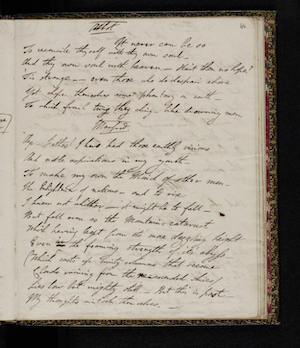

As figure 12 shows, the fair copy has longish dashes after “whither” and “fall” and “mistook themselves,” and medium-sized dashes after “abyss” and “past” that help to create a dawdling, meditative habit of mind (though one must be wary of placing too much interpretive weight on what are very variably-sized markings). The manuscript brackets in this passage encourage us to notice Manfred’s imagination snagging on a detail of external beauty, which leads him to digress from visions of himself and offer an aside on forms of natural plenitude and renewal. The dashes, meanwhile, encourage that lingering with nature that occurs when Manfred describes the Alps, or in his recollection of the Colosseum as a moon-softened necropolis.
In one of his most discerning asides, Jerome McGann calls the Alpine Journal “[o]ne of the great acts of English prose attention” (to what extent was Byron acting, one wants to ask) (McGann 177). Sights and sounds are recorded with a febrile, raw-nerved concentration for Augusta, linked by dashes that suggest Byron’s headlong plunge into each experience as he attempts to escape consciousness with an accumulation of sense impressions.
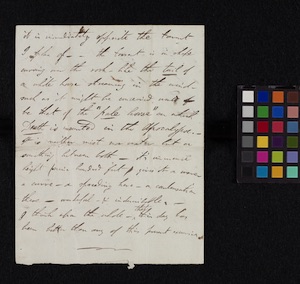
The manuscript page of the Alpine journal in figure 13 is a graphic illustration of Byron’s attempt to describe the indescribable: “It is neither mist nor water but a something between both ––.” The dash carries the affective force of the liminal “something,” which is re-transcribed in Byron’s slow realization of the lasting power of a formless form that has almost brought him to speechlessness: “–– wonderful – & indescribable. –– .” In the fair copy of Manfred, one can see the same pausa, the same pivotal seductions of the human mind by its own imaginings. This lagging, internal re-play of beauty suspends the onward rush of dramatic time and inevitability. Its backward-looking, valedictory effect is evident in my final example of a longish dash that was edited out by Gifford see figure 14).
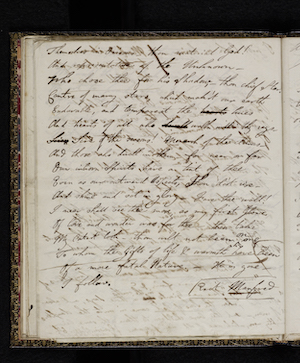
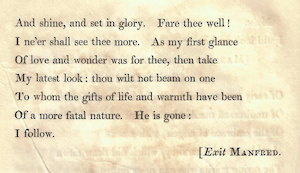
In the fair copy of Act III, scene 2, Manfred’s soliloquy to the sunset ending: “–– He is gone ––” becomes in 1817 “He is gone:” with Gifford’s characteristic colon (Byron rarely uses colons in his manuscripts). If one treats the manuscript as theatrical script, the dashes suggest that Manfred takes time to watch the sun disappear. In a stage performance, a director might arrange a shadow to lengthen into total darkness by the time Manfred reaches “gone.” A musical score might hold the final note, its echo and the silence afterwards. Manfred, we know, “must watch” (I.i.2), and the time he spends in “wanderings / And watchings” is important (III.iii.43-4). As Michael O’Neill pointed out last year when the text was discussed in the Summer of 1816 conference at Sheffield, one of the great paradoxes of Manfred is that its hero keeps saying beauty means nothing to him: “there is no form on earth / Hideous or beautiful to me,” but his speeches are full of exquisitely shaped hymns to natural beauty (I.i.184-5). Byron clearly was ravished by the Alpine scenery of 1816 which recurs throughout his poetry after the summer of 1816.
The dashes around Manfred’s acts of attention partake of what Ian Balfour notes as the “telegraphic notation” of the Alpine Journal (12), or what Susan Wolfson refers to as the “lightning on the page” of dashes in Childe Harold Canto III (765).
Manfred’s tactile attentiveness (almost adhesiveness) to form finds its echo in the very final scene where the Abbot attends the dying Manfred. Manfred expires, of course, on a dash: “Old Man – ’tis not so difficult to die. –” (Levine and McGann 130).
Neither the dashes nor the rest of the line made it into the first edition of 1817; and when the line was restored, the terminal dash was cancelled and became a full stop. As he watches Manfred expire, the Abbot reiterates Manfred’s words on the sinking sun: “He’s gone. – […] he is gone.”

And then, as figure 15 above shows, we have Byron’s lovely signing off: “End of act third – & of this poem. – . –” with a swirl that seems a more emphatic version of the one under the journal entry of September 22, 1816 in figure 13.
In the post-production discussion, the director of the Red Bull production of Manfred spoke about the challenges of adapting a poem lacking in causality for the stage. As a dramatic poem, Byron deliberately juxtaposes causality with (forgive me) what we might call “pausality.” At the micro-level of the dash and the macro-level of all those passages that had to be cut for the performance (such as the Colosseum soliloquy), Manfred steps back from decisive action to “linger yet with Nature” (III.iv.3). Poetically, he fights against the constraint that is fate or dramatic time and his dashes signal a determination to carve out form from poetic destiny so that “what ye take / Shall be ta’en limb by limb” (III.iv.103-4); “limb” is followed by three dashes in the fair copy. In the colder print of 1817, Manfred’s heroic resistance against the spirits of conventional drama becomes just another full stop. But the pause implicit in those three dashes help to make more sense of the spirit’s taunt: “Can it be that thou / Art thus in love with life?” (III.iv.107-8).
Manfred is not in love with life, but he is sensually and syntactically involved with it; he is, we might say, attached to it. Byron’s hero has his own music, and the dashes that punctuate his speech are often extra-metrical silent notes of resistance that might seem indistinguishable from the terminal silence that ends the poem. But these dashes are also cues for action; they are the echoes of the last note but also the foot prints of the next move – a halting progress that drives the poem forward. In order to see, hear and feel that complex music we might pay more attention to the dashes in Manfred.

